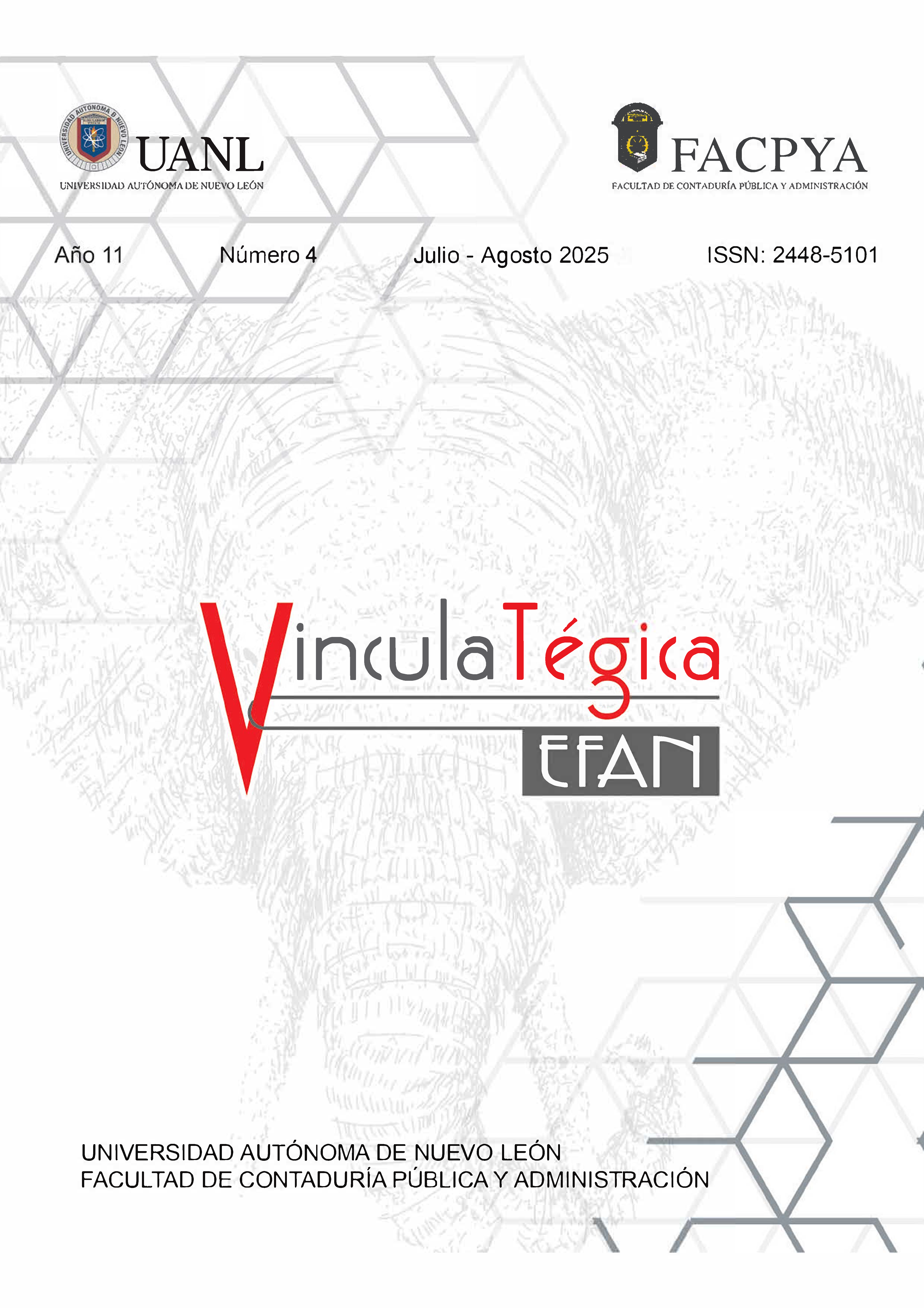Impacto Económico de la Innovación Tecnológica en la Industria Cerámica en México
Alternativas para Elevar la Competitividad del Sector.
DOI:
https://doi.org/10.29105/vtga11.4-1194Palabras clave:
Innovación tecnológica, Competitividad industrial, Industria cerámicaResumen
El estudio analiza el impacto económico de la innovación tecnológica en la industria cerámica mexicana, destacando su papel en la mejora de la competitividad. A través de un enfoque mixto (cuantitativo y cualitativo), se recopilaron datos de empresas cerámicas en Tlaxcala, Aguascalientes y Estado de México. Los resultados muestran que tecnologías como hornos de alta eficiencia, automatización del esmaltado y reutilización de residuos cerámicos han reducido los costos de producción entre un 15% y 35%, con un retorno de inversión de 2 a 4 años. Además, se identificaron barreras estructurales como la falta de financiamiento y capacitación. Se recomienda una mayor vinculación academia-industria y políticas públicas que incentiven la modernización tecnológica. El estudio concluye que la adopción de tecnología no solo incrementa la eficiencia productiva, sino que también permite acceder a mercados internacionales y cumplir con estándares de sostenibilidad.
Descargas
Citas
Albors, J., & Hervás, J. L. (2006). Contingent adoption of production technology in the Spanish tile ceramic cluster: An empirical study. Boletín Sociedad Española de Cerámica y Vidrio. https://www.researchgate.net/publication/286290692 DOI: https://doi.org/10.3989/cyv.2006.v45.i5.274
Asociación Española de Fabricantes de Azulejos y Pavimentos Cerámicos (ASCER). (2021). Informe económico del sector cerámico. https://ascer.es
Blundo, D., García-Muiña, F. E., Pini, M., Volpi, L., Siligardi, C., & Ferrari, A. M. (2019). Sustainability as source of competitive advantages in mature sectors: The case of Ceramic District of Sassuolo (Italy). Smart and Sustainable Built Environment, 8(1), 53–79. https://doi.org/10.1108/SASBE-07-2018-0038 DOI: https://doi.org/10.1108/SASBE-07-2018-0038
Braun, V., & Clarke, V. (2006). Using thematic analysis in psychology. Qualitative Research in Psychology, 3(2), 77–101. https://doi.org/10.1191/1478088706qp063oa DOI: https://doi.org/10.1191/1478088706qp063oa
Brown, F., & Domínguez, L. (1989). Nuevas tecnologías en la industria maquiladora de exportación. Comercio Exterior. http://revistas.bancomext.gob.mx/rce/magazines/172/4/RCE4.pdf
Cámara Nacional de la Industria Cerámica (CANICERAM). (2022). Informe sectorial sobre producción de sanitarios en México. Recuperado de https://www.caniceram.org.mx
Carro-Suárez, J., & Sarmiento-Paredes, S. (2017). Transformación digital en la cerámica de Tlaxcala: Casos de innovación en procesos. Revista de Innovación y Tecnología, 5(1), 65–80.
Carro-Suárez, J., & Sarmiento-Paredes, S. (2019). Cerámica 4.0: la transformación digital del sector cerámico. Comunicación Científica. https://comunicacion-cientifica.com/doi/cc235/235-04.pdf
Gabaldón Estevan, D., & Tortajada Esparza, E. (2008). La evolución tecnológica del distrito cerámico de Castellón. Universitat de València. https://roderic.uv.es/handle/10550/54233
García-Muiña, F. E., González-Sánchez, R., Ferrari, A. M., & Settembre-Blundo, D. (2020). The paradigmatic shift towards sustainability in the ceramic tile industry: A system dynamics approach. Sustainability, 12(5), 1727. https://doi.org/10.3390/su1205172 7 DOI: https://doi.org/10.3390/su12062459
Greene, M.P. (2022). Pressure Casting Sanitaryware. Ceramic Forum International. 81(11): E37-E38. https://www.cfi.de/technologies-and-materials/sanitaryware/
Hernández-Sampieri, R., Fernández-Collado, C., & Baptista-Lucio, L. P. (2014). Metodología de la investigación (6.ª ed.). McGraw-Hill Education.
Industria cerámica: Una apuesta por la economía circular. Revista Dyna, 92(1), 58–65. https://doi.org/10.6036/8476I
INEGI. (2023). Estadísticas a propósito de la industria manufacturera de productos de cerámica. Instituto Nacional de Estadística y Geografía. https://www.inegi.org.mx
INEGI. (2025). Proyección estadística de exportaciones e importaciones de cerámica sanitaria en México (2014–2025) mediante modelo ARIMA. Método de Análisis XLSTAT.
Katz, J. (1998). Aprendizaje tecnológico ayer y hoy. Revista de la CEPAL. https://repositorio.cepal.org/bitstream/handle/11362/12124/0NE063075_es.pdf
Mendoza, J. (2001). Crecimiento y especialización en la región Saltillo-Ramos Arizpe. Comercio Exterior. http://revistas.bancomext.gob.mx/rce/magazines/38/11/RCE.pdf
Molina-Moreno, V., Leyva-Díaz, J. C., & Argudo-García, J. J. (2017). Valorización de lodos en la industria cerámica: una apuesta por la economía circular. Revista Dyna, 92(1), 58–65. https://www.revistadyna.com/Articulos/Ficha.aspx?idMenu=685d6261-5410-4e92-82d3-70c3bb2fb33b&Cod=8476
Muñoz-Macias, J., Espinosa-Mendez, L. F., & Muñoz-Muñoz, M. (2025). Prácticas de Economía Circular en las Empresas Manufactureras de Aguascalientes. Vinculatégica EFAN, 11(2), 62–77. https://doi.org/10.29105/vtga11.2-1034 DOI: https://doi.org/10.29105/vtga11.2-1034
Sánchez, E., Criado, E., & Regueiro, M. (2004). La industria cerámica española ante un cambio de ciclo. Boletín Sociedad Española de Cerámica y Vidrio. https://www.researchgate.net/publication/242393957
Taisch, M., Sassanelli, C., & Terzi, S. (2021). Digital transformation and competitiveness in the manufacturing sector: A case study from the ceramic industry. Procedia CIRP, 100, 385–390. https://doi.org/10.1016/j.procir.2021.05.079 DOI: https://doi.org/10.1016/j.procir.2021.05.079
Zuluaga, O. A. (2014). Análisis del uso de la energía en la industria cerámica. Instituto Tecnológico Metropolitano. http://repositorio.itm.edu.co/handle/20.500.12622/6620
Descargas
Publicado
Cómo citar
Número
Sección
Licencia
Derechos de autor 2025 Dr. Jesus Gerardo Cruz Alvarez, Dr. Osiris Perez Moreno, MBA. Jesus Santoyo

Esta obra está bajo una licencia internacional Creative Commons Atribución 4.0.
Los autores que publiquen en la revista VinculaTégica EFAN aceptan el siguiente aviso de derechos de autor:
a). Los autores conservan los derechos de autor y ceden a la revista el derecho de la primera publicación de la obra bajo una licencia de atribución de Creative Commons. Esta licencia permite a otros compartir la obra siempre que se reconozca la autoría original y la publicación inicial en esta revista.
b). Los autores pueden establecer acuerdos contractuales adicionales de manera independiente para la distribución no exclusiva de la versión publicada en la revista (por ejemplo, publicarla en un repositorio o incluirla en un libro), siempre que se reconozca la publicación inicial en esta revista.
c). Se permite a los autores autoarchivar su trabajo en repositorios institucionales o en su propio sitio web antes y durante el proceso de envío, ya que esto puede fomentar intercambios productivos y aumentar la citación temprana y general del trabajo publicado.







